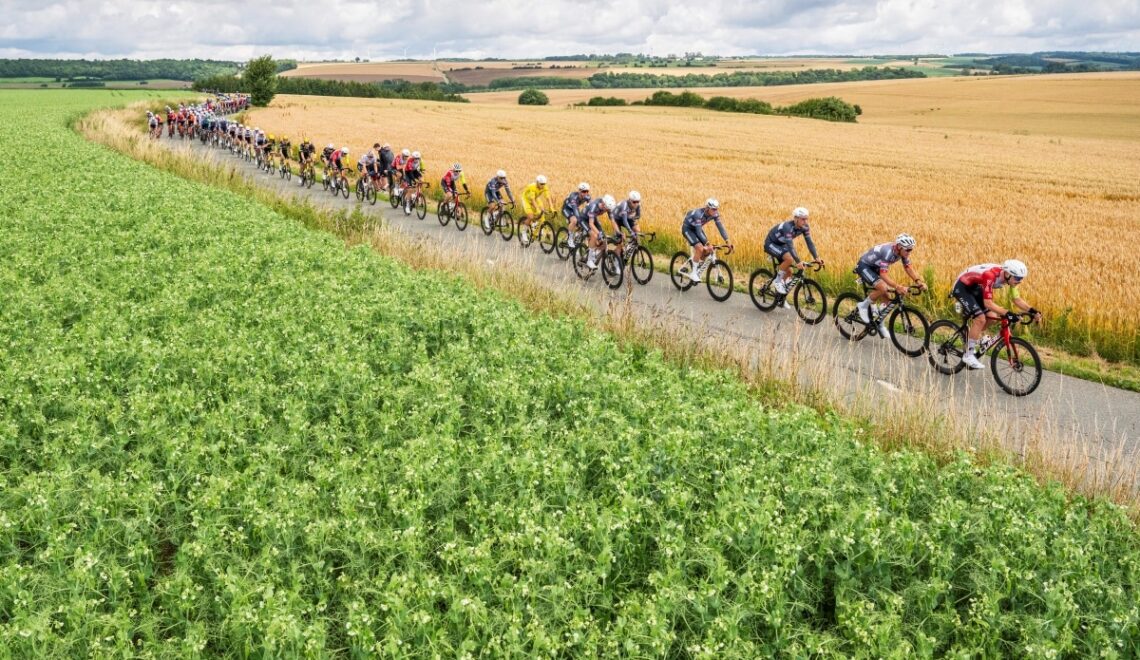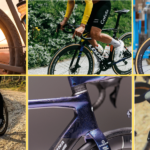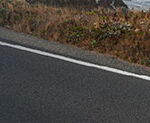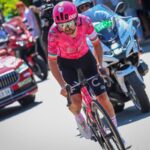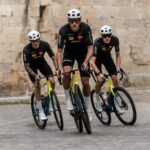
# Catch up on pro cycling – and its context within the broader world of sports – with AIRmail … Analysis, Insight and Reflections from The Outer Line. You can subscribe to AIRmail here, and check out The Outer Line’s extensive library of articles on the governance and economics of cycling here. #
Key Takeaways:
● Alpecin Dominates Tour Start
● Reusser Strong Opener in Women’s Giro
● Tour de France as Political Bellwether?
● Kids: Get on Your Bikes and Ride!
● A Looming Threat to Sports Betting?
● Nike Tiptoes Back into Cycling
A French Start To Le Tour
Fans of the Tour de France were greeted with a sight that seems to be growing rarer as the race kicked off over the weekend: a Grand Tour Grand Départ taking place in the race’s host country. The start in Lille also featured another increasingly rare occurrence: nearly every major star of the sport was present and ready, with the sport’s three biggest GC contenders, Tadej Pogačar, Jonas Vingegaard, and Remco Evenepoel, all present.

Big names and National Champions on the startline in Lille
Classics superstars and lifetime rivals Mathieu van der Poel and Wout van Aert were also all on the startline. The biggest takeaway from this showdown was yet another reminder of just how much cycling has evolved from just a few years ago, with the early racing more closely resembling a spring Classic than what fans would expect from a grand tour – moreso than even recent editions which prominently featured cobbled, Paris-Roubaix-styled stages.
Vingegaard and Pogačar rotated through in crosswinds on Stage 1 to split the field and pressure their rivals, and then on Stage 2 deftly navigated the endless twists and turns of the course to end up in a close sprint against winner Van der Poel.

This highlights just how nimble and explosive the overall winners and their teams have to be to challenge for wins and to stay well-positioned for the overall. It also reminds us of just how much things have evolved since the days of Team Sky lining their team up on the front and steamrolling the race over the full three weeks. With Ineos’ welcoming back its successful former team chief, Dave Brailsford, to return to the helm, it’s possible he may not really recognize the sport he left to run Manchester United a few years ago.

Alpecin Dominates Tour Start
One of the more interesting storylines of the opening weekend was the sight of the modestly-funded Alpecin-Deceuninck winning the opening two stages, with Jasper Philipsen taking the opening stage and then Van der Poel taking the second day and holding the leader’s jersey at least through Stage 3 (though Philipsen crashed out on that Stage. This once again demonstrates that even in an era of ever-increasing team budgets and salaries, there is still space for mid-range budget teams to thrive – if they exhibit thoughtful management decisions (and can convince the sport’s top riders to stay with them). However, when it comes to the battle for the overall, this Tour has already shown that its two best-funded and familiar teams, Vingegaard’s Visma-Lease a Bike and Pogačar’s UAE, are likely to eventually crowd out any competition at the top. But, at the same time, this hasn’t discouraged new entrants like Decathlon, which recently purchased the AG2R La Mondiale team from long-time GM Vincent Lavenu, and reportedly signed on L’Oreal as a co-sponsor. The revamped team has reportedly committed to a €40 million annual budget in an attempt to finally bring a Tour victory back to France, with their young French star Paul Seixas.

Paul Seixas, France’s next Tour champion?
It is always great to see teams securing major international companies as partners, but this also seems like an immense amount of pressure to place on an 18-year-old who is far from a finished GC product and has a long way to go before being able to challenge for wins at top stage races. And that’s assuming none of the so-alled super-teams poach Seixas. As for Vingegaard and Pogačar – the top GC stars to emerge in the last few seasons – being able to develop in relative anonymity likely helped them evolve into their current status.
Reusser Strong Opener in Women’s Giro
The Giro d’Italia Women kicked off on Sunday with a time trial and Marlen Reusser (Movistar) fired yet another volley over the bow of the Women’s WorldTour, winning the stage by 12 seconds over EU time trial champion Lotte Kopecky (SDWorx) and 16 seconds over defending Giro winner Elisa Longo Borghini (UAE).

Kopecky’s teammate Anna van der Breggen was 20 seconds off the pace in her first race back since abandoning the Itzulia tour in mid-May – a race emphatically won by her former teammate Demi Vollering (FDJ), who is not racing the eight day Italian event. At the start of the season, cycling pundits (including us) were predicting a season-long battle between SDWorx and FDJ for supremacy in the WWT: World Champion Kopecky and returning star Van der Breggen vs. their former teammate Vollering. And for most of the season so far – including an exceptional spring Classics campaign and an on-fire Vuelta in which Vollering decisively dispatched Van der Breggen in the high mountains – that was the storyline.
However, Reusser hasn’t just quietly entered the fray, she’s rewriting the plot. An exceptional time trialist, she spent several years in the SDWorx program in the service of both Kopecky and Vollering, and scalped several big wins including three consecutive EU time trial championships and stages at the Giro and Tour de France Femmes. She also won the Itzulia and Tour de Suisse in 2023; flash forward to 2025, and leading her own team, Reusser has won Burgos and another Tour de Suisse and has proven, at age 33, that she hasn’t lost her power against the clock but has also learned to defend when in the lead.

Her powerful and steady climbing in Spain and Switzerland firmly established her credibility as a legitimate stage race star and potential TdFF winner. A supporting storyline to Reusser’s rise is the fortunes of SDWorx – the once-dominant team in women’s pro cycling is still a prime mover, but talented riders it could not afford to retain have struck out and reshaped the peloton. Anna Henderson (Lidl-Trek) may have taken the race lead on Monday – and Vollering’s star status at FDJ notwithstanding – Reusser has become more than just a wildcard, but a true stage race ace.
Tour de France as Political Bellwether?
The GeoSport substack of Prof. Simon Chadwick, one the sport’s most visible cultural commentators, took on the political significance of the Tour de France. According to Chadwick, it has been ten years since Dalian Wanda, the mega-company from China, owned by its richest individual at the time, was rumored to be interested in acquiring the Tour. Wondering what might have happened had a deal materialized, Chadwick says, “In some ways, the Tour de France remains the sporting symbol of a bygone era, though in other ways it is on the frontline of white heat issues that are now dominating many sports.” He discusses cycling’s well-known and almost total dependence on sponsorship, and its recent gravitation towards both sovereign state and energy company sponsors – leading to allegations of the exploitation of the sport for both “sportswashing” and “greenwashing” purposes. His critiques or questions are oriented not just to the oil-rich emirates and their efforts to build “soft power” through sport, but also the Israel Premier-Tech team, and its partial funding by a unit of the Israeli state. He warns of possible activist disruptions to the race this year, and concludes that the Tour “is nowadays much, much more than simply a celebration of everything French.”

Kids: Get on Your Bikes and Ride!
The venerable Atlantic magazine weighed in this week on the cultural significance of bicycles, decrying the gradual collapse in – basically – kids riding bikes. Thirty years ago, “an average of 20.5 million children ages 7 to 17 hopped on a bike six or more times a year” – a statistic that has now fallen by more than half. Bemoaning the global tendency for most kids to spend more time indoors and in front of screens, the article highlights both the cultural and physical benefits of cycling, with its growing risks and safety considerations. The author makes the plea for more bike infrastructure, and emphasizes the value that independent bike transportation could bring in terms of raising more confident and resilient kids. What many kids need in order to achieve those traits is “a bit more freedom: time to do as they please, to pedal aimlessly—until, one day, they’re ready to take off.” For the boomers or Gen-Xers among us, it calls to mind the directive from Freddy Mercury on Queen’s 1978 “Jazz” album, to “get on your bikes and ride!”
A Looming Threat to Sports Betting?
On Monday, the Huddle Up newsletter drew attention to a little noticed clause buried deep inside President Trump’s “One Big Beautiful Bill Act” that could destroy sports gambling in America. Section 70111 states that the tax deductibility of gambling losses will be capped at 90% starting next year. Previously, 100% of losses had been deductible against winnings. In effect, gamblers will now be taxed on the extent of their participation rather than on the amount of their winnings. Potentially, this “could trigger a chain reaction that could potentially lead to the industry’s destruction” – impacting not just small-time bettors, but also professional gamblers, casino and sportsbook operations, and even state governments which have put in place on-line gambling policies and laws to raise tax revenue and generate additional economic activity. We wonder what drove the inclusion of this clause, and what may happen once more people learn about its existence – particularly the small-time bettors who make up an outsized portion of day-to-day sportsbook wagering.
Nike Tiptoes Back into Cycling
Nike as a brand has undergone several iterative relationships with professional cycling, and may be reestablishing a stable presence for the first time in over a decade. The “swoosh” first made a meaningful splash in 1988 when it introduced a line of shoes and sponsored the 7-Eleven team, although not all the riders chose to wear the gear. The brand then waxed and waned throughout the 1990s before roaring back with another American-sponsored team, US Postal, in 1998 – or rather, with USPS’s most visible rider, Lance Armstrong – in his first comeback campaign. The prominence of that relationship yielded an unprecedented multi-level and sustained marketing channel around the Armstrong life story, a Nike corporate campus building bearing his name, and a diverse line of shoes and clothes that was popular throughout the ‘00s. All of this unceremoniously collapsed in 2012 after the USADA Reasoned Decision. The brand damage control (which included renaming that corporate building) lingered for many years, with only a personal shoe sponsorship for Mark Cavendish and a line of indoor spin class gear to break the brand’s cycling silence.
Flash forward to 2025, and – surmised from several former and current Nike insiders – the ice may finally be thawing. Looking into the findings of the recent Women’s Sport Trust semi-annual report, there are clues as to why. A major personal sponsorship and marketing campaign with Demi Vollering, and the recently announced “lifestyle clothing” sponsorship with the Visma-LAB team may indicate that Nike has done its homework: individual athletes have reshaped the brand relationship playbook through their digital presence and often have a greater impact on merchandising and marketing than entire competitive leagues.

A lifestyle clothing placement with a team helps the brand to connect with fashion-conscious cyclists – and hopefully non-cycling fans of the sport – while key athlete relationships tap into direct, nearly 1:1 consumer relationships. Given the brand’s often tumultuous history via a veritable rogue’s gallery of controversial athletes and programs, from Armstrong to Marion Jones to Shelby Houlihan, and the entire Alberto Salazar “Oregon Project” morass, Nike might be testing the waters before committing again to pro cycling’s long and winding marketing road. And this is a welcome development as our sport seeks to reengage brands and markets that could reach a broader sports fan audience.
# Catch up on pro cycling – and its context within the broader world of sports – with AIRmail … Analysis, Insight and Reflections from The Outer Line. You can subscribe to AIRmail here, and check out The Outer Line’s extensive library of articles on the governance and economics of cycling here. #
The post The Outer Line : Alpecin On Fire, Women’s Giro and Sports Betting appeared first on PezCycling News.
